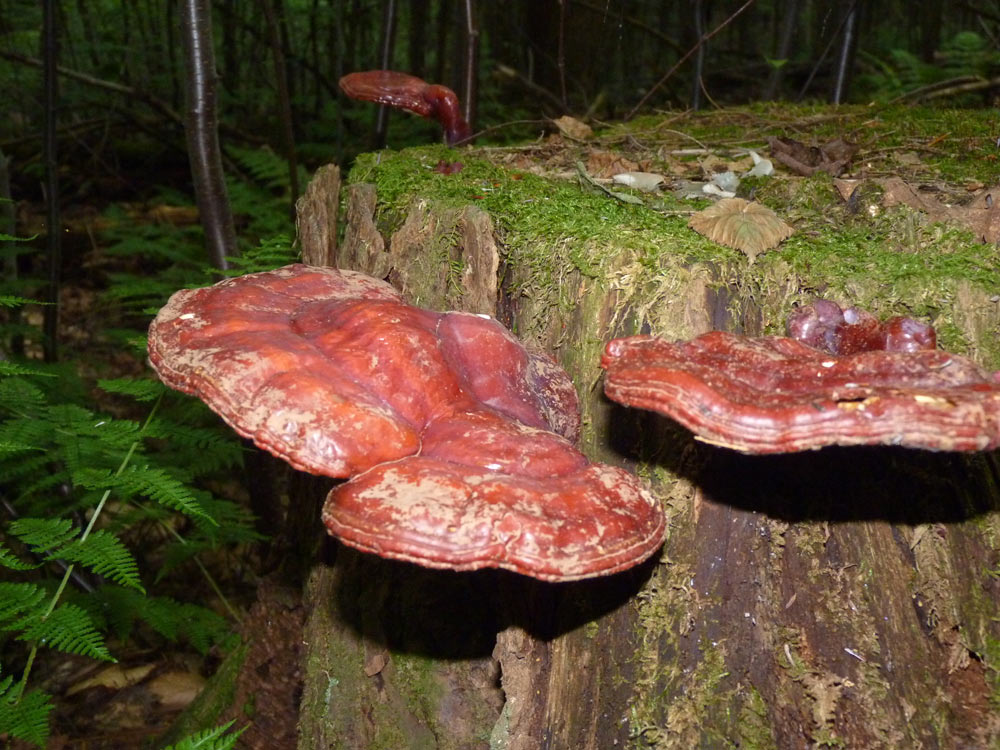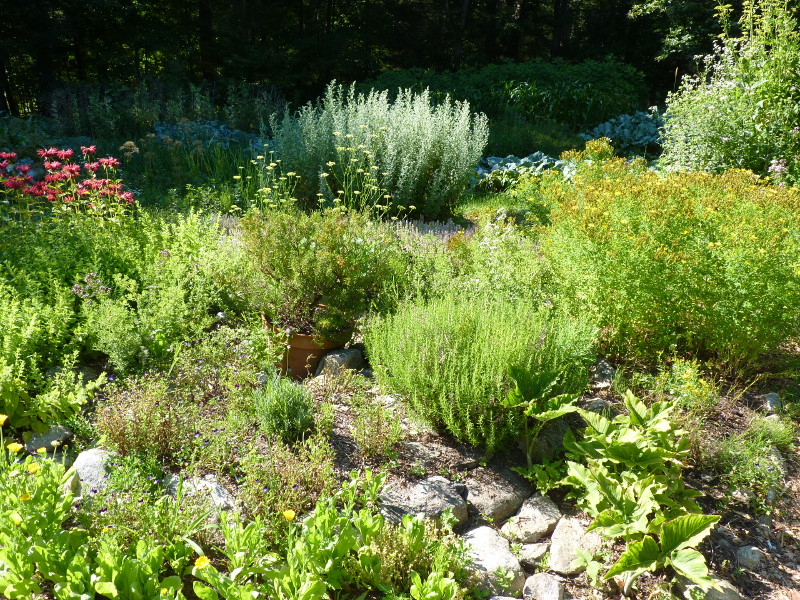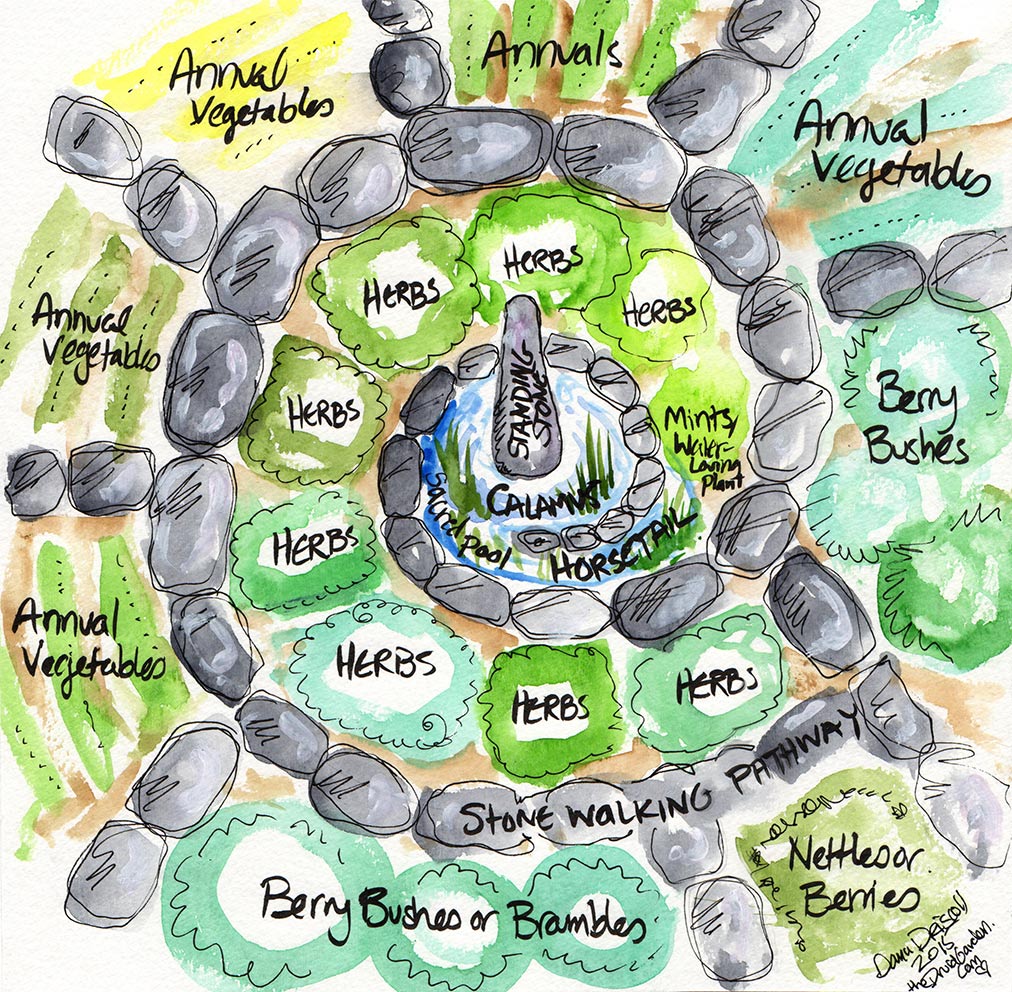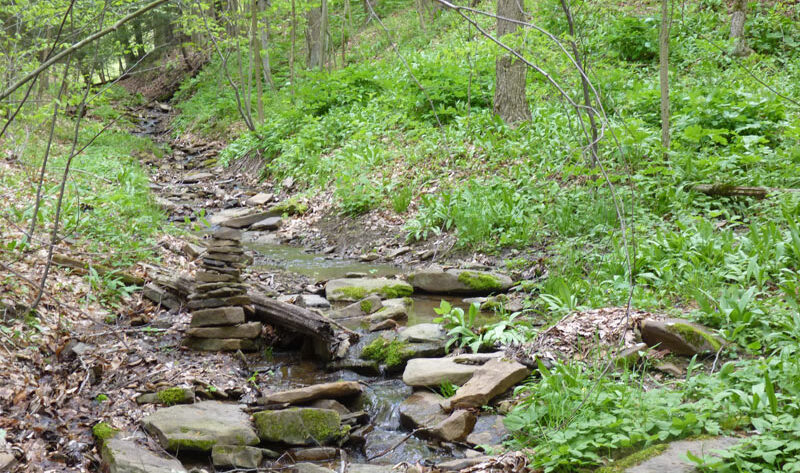
Many years ago, I shared the story of the “mystery of the stumps“, which was my path into druidry. I grew up spending all my days in a forest that was rich, full, and bountiful. When I was 14, that forest was logged. My heart broke, and afterward, I tried to enter the forest but it was horrible: downed trees everywhere, so much damage, so many friends that had been cut and taken away. I thought the forest would never heal. I withdrew not only from nature, but from my spirit and creative gifts, and spent a time in numbness and mourning–a period that lasted almost 10 years. I didn’t return to the forest till I was 24. When I finally went back in, so much had changed–the land was regrowing. Large thickets of birch, blackberry, and cherries were everywhere, springing up to regenerate the land. It was then that I discovered the Reishi mushrooms on the stumps of the hemlock trees, a testament to the true healing power of nature. Not only had the forest regrown–but it had produced some of the most potent natural medicine on the planet for humanity.
I retell this story today because I think its important to realize how much time it takes nature to heal. Nature works on “slow time“–seasons upon seasons, cycles upon cycles, each year passing where nature, given the opportunity, works towards ecological succession and more complex and interwoven ecosystems. When I entered the forest just after the logging, the forest was so damaged. If I had returned even a few weeks later, however, I would have likely started to see the first stirrings of rebirth and renewal. Where the forest canopy broke, new plants and trees could spring forth. The seeds and seedlings were already there, waiting for their opportunity to heal. Every year after, more healing and growth take place. Slow, but steady is nature’s healing pace.
Just as nature uses time to heal, so too, can we use ritual and sacred space over a long period of time to help enact nature’s healing. Today’s post explores this idea through the development of a “grove of renewal” that works with time and the seasons and focuses on both inner and outer magical practices and techniques for healing. Using this approach, we might see the druid and the living earth walking hand-in-hand to enact healing upon the land. As nature heals through the seasons, we, too might use this same principle for land healing
(I will also note that this is a post in my land healing series, which is now sprawling over several years with many posts! For other posts in the series, you can see A Druid’s Primer on Land Healing I, II, III, IV, V, VI, VII, VIII, IX, as well as rituals and more rituals, and finally, refugia and permaculture as physical land healing practices. Those aren’t required reading for this post, but certainly offer many different perspectives on land healing: what it is, different approaches, and different ways we might work with it.)
Slow time, Slow Ritual, and Nature’s Healing
Part of the challenge we have in the ecological reality of the 21st century is time. Our culture moves very quickly, with cycles of consumption and production intense and overwhelming. Everything is too fast, as I shared in my earlier series on “slowing down the druid way.” Fast food, fast lives, fast jobs, fast relationships; everything moves so quickly. Sometimes, we unfortunately try to apply this same thing to our spirituality and expectations. One-off rituals or false starts, rather than sustained practices. The speed of the 21st century doesn’t just influence us: it also means that nature is being consumed/destroyed/damaged much faster than she can heal. Part of the challenge, too, is that the earth takes time for damage to show: melting ice caps and glaciers aren’t responding to today: they are responding to previous years, and we won’t see the full effects of today’s carbon emissions for some time.
But nature’s own powerful lesson resonates deeply here: with healing, time moves differently. This is true of land healing as much as it is true of our own heart healing. One way nature heals is through a process called ecological succession. Ecological succession, from a mowed lawn to a pinnacle oak-hickory forest (which is the final ecosystem where I live) takes about 250 years. That is, if lived in my region, and you stopped mowing your lawn today and did nothing else, in about 250 years you’d have a mature oak-hickory forest. Or, maybe you could speed that up to 75 years if you planted all the oaks and hickories in your front lawn (and again, stopped mowing)! This same lesson applies to us, as we are part of nature: time heals all wounds in ways nothing else will. Time is the ultimate healer.
Most of the time when we think of ritual, we think of a single event, a sacred moment in time. We do a ritual, it is good, the energy radiates outward. This is also true of a lot of land healing: we do a ritual to heal the land, and hope it has some effect. However, this isn’t the only approach. I’ve been developing a technique that I call the “Grove of Renewal” that uses permaculture design, more than traditional ritual, and works with nature’s ultimate healer: time. So, rather than thinking about land healing as a ritual or series of actions, I’m thinking about it as a permaculture designer: cultivating a space for healing as an “extended” ritual over time. By focusing efforts on a small space, that healing energy can radiate outward to the broader landscape for the benefit of all.

The “Grove of Renewal” approach focuses on one small space. By focusing our energies on this one space, we can help this space heal in a powerful way. Each day and cycle that goes by, more healing happens both physically and energetically. At some point, your grove of renewal is a healed and healthy space, so much so that you can now direct that healing energy outward in a much broader way. Its important to note that this is slow magic, very slow magic. It unfolds over a period of years, and thus, requires patience, peace, and connection. You are building a relationship with a piece of land as a healer, observing and interacting, and doing regular work. You are on nature’s time.
So let’s look at how you might create your own “Grove of Renewal”! First I’ll explain the basic steps and then I’ll share my own example so you can see how one of these might work in action.
Step 1: Choosing Your “Grove of Renewal” Space.
For your grove of renewal, you’ll want to choose a small physical space to help heal. Perhaps it’s a segment of lawn you want to convert to a native plant garden and butterfly sanctuary, perhaps it’s a strip of land behind an alley nobody cares about. Perhaps its a new piece of land you just moved to, and you can now tend. Wherever it is, you can make this place a center of land healing, your own “grove of renewal.”
On the physical level, this should be a space where physical land healing can happen. That is, it should be a space that is protected in some way (in the sense that someone else isn’t going to come and mow down all of your efforts). It should also be a space that you have direct and regular access to, the easier, the better.
On the metaphysical level, you also need the “go ahead” from spirit–that you are working in accordance to the spirits of the land and their wisdom. Thus, you might be directed towards a particular place where spirit wants this grove of renewal to happen. Use outer and inner listening techniques and make sure you are aligned with the land itself.
Selection is so critical, as you will be working in this space extensively over a long period of time. Take as much time as you need for this step–remember, this is slow healing, slow time. Make offerings, visit a number of times, and allow yourself to resonate with the space. In permaculture design, a year and a day is not unreasonable and is a generally accepted permaculture design technique for observation and interaction. That’s the kind of slow time I’m talking about here. When you are certain it is the right place, move on to step two.
Step 2: Create your plan.
Because your grove of renewal will function as a shrine for physical and energetic land healing, you want to consider what kinds of things would work best with that intention and any other specific intentions you may have.
On the physical level: Create a plan for the plant life and animal/insect/bird/reptile/amphibian life that you want to invite to the space. If you are working from scratch, you might be able to carefully design it. If there is already life there, you will want to work with it and tend it. Learn what kinds of plants are native to the area, what kinds of plants support diversity, and build diversity in. Learn what used to grow there, and think about how you can help restore it to a healthy ecosystem. You might combine this with other physical land healing techniques, like the refugia garden.
In order to do this work on the physical level, you will need to carefully observe and interact with the space over a period of time. Think about the space you have already (wind, light, soil, water, potential pollutants) and how you might intervene. Consider what you want the final result to be in 10 or 50 years: a forest environment, a wetland, a meadow with wildflowers, etc. Consider what plants may grow there that are rare and endangered. Consider what insect life and wildlife may need a space to live. Look at what may already be growing there–what will you do with what is there? Will you remove it and plant natives? Will you work with what is growing? These are important decisions!

On the spiritual level. Since this is also a ritual space, you may also want to mark it ritually in some way. Thus, sacred objects can be included in the plan, but should be naturally based and locally sourced. You might create a stone altar, stone cairn, use statuary, decorate the space with found natural objects (shells, bones, stones, etc), hang a flag, etc. I like to decorate my shrines based on what I can find locally and in the immediate area.
Putting it all together. Once you have the pieces in place, create a plan: what do you need to do first? Second? Third? Realize also that the best-laid plans can be changed, so also be ready to adapt as necessary. Nature isn’t going anywhere!
Step 3: Create the Space, focusing on inner and outer work.
Creating the space itself should be a ritual activity, working on both the inner and outer planes. I suggest timing your beginning of the work to one of the eight festivals in the druid’s wheel of the year. When you are ready to begin, take your first step and start the work. You are working both on the physical and the level of spirit.
Spiritual work. I usually start with spiritual work. One of the things I’ve done to help further this work is to create a permanent sacred space. I do this similar to creating an open grove (or open circle, like the kind you’d use for magical work or celebratory work), but creating it as a sacred space with a particular intention: healing. Additionally, I strongly recommend putting up energetic/magical protections around the space and renewing these regularly.
Other spiritual work may also unfold, such as creating a shrine or other permanent spiritual focus for the space.
Physical work. Physical regeneration of land usually involves building soil fertility, planting trees or other plants, and doing any other clean-up that is needed. This work takes muscle, time, and regular tending. See this work not as a moment in time, but as a process that unfolds (much like growing a vegetable garden–it takes a plan, seed starting, planting out, tending/weeding, and harvesting, all before you begin the cycle again!)
Step 4: Visit your space regularly and let it flourish.
After your initial work and once you have things in place (which may take you some time), it is time to let nature do its own healing. Visit your space often as it grows and heals, pay attention to the ways that the energies of that space may change. Pay attention to these changes on both an inner and outer way:
- What is growing there that you haven’t seen before? Can you identify it?
- If you planted anything, how are the plants growing?
- Observe life: insects, birds, animals, etc. Do you see anything new?
- How does the space change in different seasons?
- Energetically, do you sense any shifts? If so, what are they?
- How do you feel when you are in the space?
- What messages from spirit might you be experiencing?
This step requires us to be very intuitive. You come and visit as you feel led to do so. I suggest, at minimum, visit at least once each quarter of the year (for example, at the spring equinox, summer solstice, fall equinox, and winter solstice). You don’t have to be visiting every day (although you certainly can). In my own experience, its almost better to let nature work on her own for a time and then return.
Another thing sometimes happens: nature tells you to leave the space alone for a while. The space needs its own energy and time, and you may be asked to let a year or more pass before you are asked to return. Honor any requests made to you on the part of spirit.
Step 5: When the space is healed, radiate that healing outward.
At some point, your space will have very positive energy, a sense of peace, and quietude that only healed spaces can have. This may take place across a single season or series of seasons. Or it may be a very long process, depending on the healing that you are working to enact. You’ll know when the time is right; this space will be bursting with energy and you will feel it start to flow outward. At this point, you can do a “radiance” ritual, envisioning the sun and earth’s energy and radiating it outward. This ritual can be as simple as meditating on the energy in the space and encouraging the excess to flow outward into the landscape and to places where it is needed. Again, working intuitively here, with spirit, can be helpful.

Example: A Woodland Grove of Renewal
For the last two and a half years, I’ve been working to convert a burn pile on the edge of a forest on my own property into a Grove of Renewal. This wasn’t the first space I’ve tended in such a way, but it certainly is my most intentional of spaces. My first step was identifying the space: I was starting a fire one day and looking for some extra kindling. I wandered into a section of the property I hadn’t really explored before. Suddenly, I saw this beautiful circle of stones surrounding a stump–it was calling to me, almost radiating light in my direction. As I got closer, I realized, sadly, that these stones had been used as a burn pile, and had half-burned plastics, lightbulbs, wires, hairspray bottles, and much more all over them (there were many such burn piles on my land when I arrived here). My first task was to sit with the space for several sessions quietly, meditating on the energy of the space. In one such session, I brought my drum and drummed a bit, but otherwise, simply listened and held space. This lasted some months, through the fall, winter, and into the spring.
Once I felt the impetus to proceed, I set up a small altar nearby and then cleaned up the space, which had many years of garbage and debris from burn piles. I chose to start this work at Beltane and conclude it by the Summer Solstice. I recycled what I could and removed what I could not. At the summer solstice, I also stood a large stone upright to bring light and healing energy into the space. I brought in additional materials to help the soil heal from the toxic ashes; leaves I had been composting from another part of the property and some aged manure to increase the soil fertility. I was planning on adding plants, and I wanted them to have good and fertile soil. Since this was a woodland environment with already mature tree cover (oak and hickory, yay!), the following season, I decided to populate the shrine with some of the rare woodland species that have been disappearing from the landscape. Here in the Appalachian mountains, we have many such species under dures due to overharvesting including three I selected for the shrine: black cohosh, ginseng, and goldenseal. I planted these around the shrine and tended them until they were well established (and I’m still in the process of tending them and adding additional plants).
Now, I am in the process of creating a small pathway into the shrine and going through that section of the woods–with the idea that the rest of the woods is sacred, and this path is the only path that should ever be walked by human visitors. That will further protect my rare woodland species. I have already created a small pathway into the shrine, planting solomon’s seal (another native woodland medicinal) at the entrance. While this was ongoing, I am continuing to do regular ritual with the space, helping clear it energetically of the “burn pile” energy and bringing it into a more positive place. I’m also just visiting the space from time to time, saying “hello” and seeing what is going on. Regularly, at the new moon, I work with the space, usually doing some flute or drumming. Since establishing this space, I have had a pileated woodpecker pair who have moved into this patch of forest and is now nesting nearby. I also regularly see Jays, Sparrows, and many others

It still has a lot of time before the energy builds enough to radiate outward and send the flow of healing energy back to the land, but I know it will. At that time, I will work to create a flow of healing energy from that space outward into the surrounding environment (which in the vicinity, includes strip mining, coal mining, and factory farms).
Concluding thoughts
The “Grove of Renewal” is a simple yet profound technique to help you establish a space for healing energy: both for an immediate ecosystem in need of healing, but also, as a way to engage in land healing energetically in the broader landscape. I think this is exactly the kind of work that druids can do who want to “give back” in some way. Your “Grove of Renewal” is likely to look very different than my own, but any space can be brought back physically and energetically to a place of healing, light, and life. And certainly, this is work worth doing.




Reblogged this on Blue Dragon Journal.
Thanks for the reblog!
[…] Source: A Druid’s Primer on Land Healing: A Healing Grove of Renewal | The Druid’s Garden […]
Thanks for the reblog!
[…] Source: A Druid’s Primer on Land Healing: A Healing Grove of Renewal | The Druid’s Garden […]
Thanks for the reblog!
Reblogged this on Paths I Walk.
Thanks for the reblog!
[image: E]den, now Earth – or Gaia to some – is virtually bereft of Divine Man, male and female.
Now populated by a tough, scraggly eco-system of survivors, our planet now follows a faltering trajectory, punctuated by extreme seasons, along an elliptical orbit around Satan’s Sun; a harsh, scorching heat-source to the darker races of the Tropics, and an all-day-and-night eerie glow to the lighter Nordic and Polar Regions races.
This assorted peoples, fragmented descendents of the original One Race of Divine Man – unaware of, or overlooking the Tree-of-Life – have been motivated for millennia by a tree whose fruit bears death, the wage-of-sin. Although forewarned, an unwise humanoid designed to serve a rogue-element Divine Man, was enticed by his cloned helpmeet companion to share the fruit of the narcotic tree, and subsequently died, but not before initiating descendents that would eventually populate the evacuated planet that became Earth after Divine Man ascended. In the absence of Divine guidance, superstition has prevailed in forms of fear-motivated belief-systems labelled ‘religion’. Those less subject to fearful superstition embraced a control mechanism known as, ‘political government.’
Ascension cycles of longevity – measured in thousands of years of creative activity – known to Divine Man, male and female, were reduced to a few decades during the Caveman Stage, and have evened out to between seven and ten decades for those avoiding illness and accident, war, or execution. However, the semi-comatose state of the surviving races of mankind has no recollection, between generations, of origin, meaning, purpose, or the Tree-of-Life. Some indigenous peoples, unaffected by education – (a form of learning, devised to substitute the purpose-of-life, by industrialised trading systems developed to sustain humanity) – have kept a word-of-mouth historical account recalling a Golden Age, and yet even that has been eroded by credibility wisely tempering the story for their youngsters, who would otherwise consider the tales as wild exaggeration; giants, levitation, ascension, a translucent species of God-Beings?? No, dumb it down for the sake of preserving credibility; just say “*a turtle emerged from the sea*” (the civilisation of Atlantis, after Lemuria was lost), and “*We dreamed and the world came about as a dream-state*”, (following the submersion of Atlantis).
Yes, there has been a serious glitch – a series of extraterrestrial upheavals disturbing the creativity of those sharing their creator’s dominion in Eden – but amounting to no more than an unfortunate blink-of-the-eye, timewise, from the perspective of larger time-cycles spanning the Ages of eternity.
Fortunately, life prevails, and, where resistance is lower, or less superstitious, the intelligence of life is reclaiming lost ground in the human mind previously traumatised, and sedated by los-of-consciousness; a protective-measure of life that mercifully preserved a degree of sanity since the Caveman Stage and the following Dark Ages, where hunter-gatherers – leaving death and destruction in their wake — plundered the environment of planet earth.
Clearly, if resource-exploitation remains unchecked, Eden’s once abundant provision would be diminished to exhaustion by sprawling self-centred humanity’s exponential growth. I therefore commend you in your creative restorative appreciation of Mother Nature’s seasonal contribution towards healing our war-torn planet. Keep up the therapeutic work, and never underestimate the power of conscious appreciation – syntropy will restore our race to consciousness in due course. Thank you again, Peter
On Sun, 30 Jun 2019 at 13:07, The Druid’s Garden wrote:
> Dana posted: ” Many years ago, I shared the story of the “mystery of the > stumps”, which was my path into druidry. I grew up spending all my days in > a forest that was rich, full, and bountiful. When I was 14, that forest > was logged. My heart broke, and afterward, I” >
Hi Peter, thanks for reading and for your comments. Lots to think about here. Getting our resource exploitation, in check, is the only way to save much of what we love and hold sacred–the living earth. Your comments on education, too, strike a chord. How much of modern education’s goal isn’t to educate for free thought, reason, evaluation, creativity, and curiosity but to indoctrinate? Those things would likely arise naturally, and stay, but instead, we “educate” away some of the very best qualities of humanity–and those that would most serve us best during this very challenging period of time. Blessings to you, Peter!
Reblogged this on dreamweaver333.
Reblogged this on ravenhawks' magazine.
I have been tending our land on which my husband and I bought and built our home for almost twenty seven years, On one particular section I worked to make it a sanctuary for native plants, many of them on the United Plant Savers At-Risk and To Watch lists of woodland plants. When we first bought our land there was one spot that had an old cellar hole surrounded by large birch, ash, and maple trees. The old brick chimney had collapsed into the hole, and for almost a hundred years the people in the town had used the cellar hole to dump garbage, and everything from bottles to old shoes and metal that had long ago rusted into unidentifiable pieces. It took two summers of hauling junk and garbage to clean out the cellar hole and the surrounding area. In the process of cleaning it up I found an old cobblestone well nearby that looked to have been put in at least as early as the mid 1800’s. It had grown moss over the stone covering and been almost buried in leaves when I found it. We cleaned it out and I used the water in it to draw from to hand water the plantings I made. I turned the old cellar hole and the land around it into a sheltered woodland growing space for native plants. Over the years I got plants from United Plant Savers, from New Hampshire nurseries that were propagating native plants, from rescue sites where they were going to bulldoze for development, and I also gathered seeds from some of the native plants that were already growing on our land. Today there are colonies of Black Cohash, Blue Cohash, Trilliums, Bloodroot, Goldenseal, Mayapples, Wild Ginger, Partridge Berry, Aralia, Wild dwarf Iris, Jack-in-the -Pulpits, Solomon’s Seal, and various ferns. I love to sit and meditate in that spot. I have often blessed the area on holidays and to mark the seasonal changes, and leave offerings outdoors on a large flat granite stone. I also give educational tours of the site and have had Girl Scouts, Day Camps, 4H groups, and various adult groups, and individuals like nurses here to teach them about identifying the native plants, their historical and medicinal uses, and how important it Is to save and protect our native plants. Many of our visitors feel it is a place of peace, and I think it radiates healing energy and peace to the surrounding area.
Wow, it sounds like a magical, wonderful, and incredible place! I love Jack in the pulpit–one of my very favorite plants. Blessings to you, Niniann!